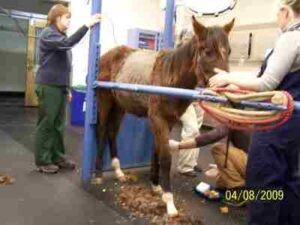Article:
Cooperative Efforts Shuts Down Irresponsible Racehorse Breeder Ernie Paragallo
On May 18, one-time Wall Street executive and disgraced racehorse breeder Ernie Paragallo was led away in handcuffs after Greene County Judge George Pulver sentenced him to two years in jail and a $33,000 fine. In March, Paragallo was found guilty of 33 counts of animal cruelty in a non-jury trial presided over by Judge Pulver and prosecuted by Greene County District Attorney Terry Wilhelm.
Though Paragallo apologized and his attorney pleaded for a light sentence, Judge Pulver would have none of it. In addressing Paragallo, Judge Pulver said, “Your sense of integrity, your code of conduct, your perception of right and wrong, was perhaps formed by your days on either mean streets or Wall Street. Money, the bottom line, and opulence in your mind, trumps morality, honesty, and civility.”
A hearing to determine the amount of restitution that Paragallo must pay to Equine Rescue Resource of Orange County and the Columbia-Greene Humane Society will occur in July.
A chain of events, involving several agencies, brought this case to light and succeeded not only in ending the suffering of the horses on this particular farm, but also in improving the oversight of breeding farms across the state.

In April 2009, an upstate horse dealer purchased some horses that she believed could be rehabilitated from a trader who buys and then sells horses for slaughter. The horse dealer noticed another group of horses too emaciated to be sold — even for slaughter. Upset by their appearance, the dealer contacted a Pennsylvania (PA) horse rescue group that bought and trucked the skinny horses to PA. Subsequently, it was discovered that the horses had belonged to Paragallo. The news that Paragallo had sent emaciated horses to slaughter went “viral” on the Internet.
Seeing this frightening report, a woman on Long Island who was boarding a yearling and his mother at Paragallo’s farm became concerned. She contacted the PA rescue for assistance, and they in turn reached out to Colleen Segarra of Equine Rescue Resources in Orange County, NY. Segarra agreed to visit the Greene County farm and remove the two horses. Shortly before Segarra’s arrival, the woman called the farm and ordered them to give the horses to Segarra.
When Segarra arrived, she watched as some horses were being chased by a tractor. Shortly afterward, she was presented with the yearling who had a leg injury, resulting from the chase, and half the size he should have been. She asked to be taken to his mother, and as she walked through the barn, she saw various emaciated horses. When she asked why they looked like that, the barn help told her that there had been insufficient food all winter. She got to the stall with the mother and was horrified. The horse was underweight, covered with lice, and suffered from serious hair loss.
Segarra immediately called the area State Police (SP) barracks to report the conditions. As the SP were unable to respond to the scene immediately, Segarra loaded the two horses and drove them to the barracks. Upon seeing the condition of the horses, the SP had Segarra, an experienced horsewoman, write a statement describing what she had seen at the farm. Subsequently, the SP, with the assistance of Columbia-Greene Humane Society (CGHS), executed a search warrant on the Paragallo farm. CGHS took charge of 177 horses and impounded them on the property. Paragallo surrendered most of the horses. Though some had to be euthanized, homes were found for the rest.
Later that month, in an apparent effort to befriend Segarra, Paragallo contacted her and offered to pay the cost of the Cornell veterinary care that was necessary for the yearling and his mother. Segarra, alarmed, contacted NYSHA. NYSHA had provided Segarra with guidance on other cases in which she was involved and had coached her through a challenging security posting hearing. In this situation, NYSHA advised her not to talk to him as his behavior constituted witness tampering and to report Paragallo’s actions to the DA’s Office and CGHS which she did.
Months passed before the case was concluded, but it was worth the wait. In addition to the sentence, some long-term changes have occurred. In December 2009, the New York Racing Association (NYRA) said it would bar owners from racing if any of their horses were sold for slaughter. The NYS Racing and Wagering Board (Board) forced Paragallo to surrender his agent’s license, and his daughters gave up their owners’ license. (Paragallo had previously lost his owner’s license because of improper business dealings.) When Paragallo began selling his healthy racing stock, the Board stopped his sales, pending a Board decision on the case. The Board further started an action that would prevent Paragallo from ever racing again in NYS and impose civil fines stemming from the 33 counts of cruelty. In addition, the state’s Thoroughbred Breeding and Development Fund, from which Paragallo had collected hundreds of thousands of dollars over the years, has now established stringent, yearly inspection standards for the 400 breeding farms in the state, rather than acting only as census takers.
What you can do:
- One person can make an enormous difference. If you see cruelty, report it. Do not be deterred.
- Please support NYSHA, so we can continue to provide animal cruelty investigation workshops and to act as a resource to the community.
New York State Humane Association Humane Review,Vol. XXIV, No. 1, Spring/Summer 2010.